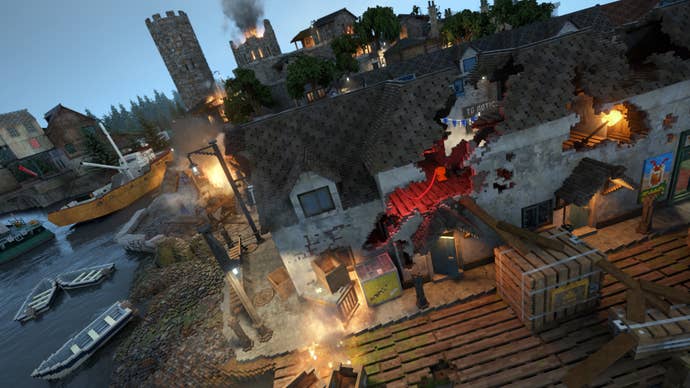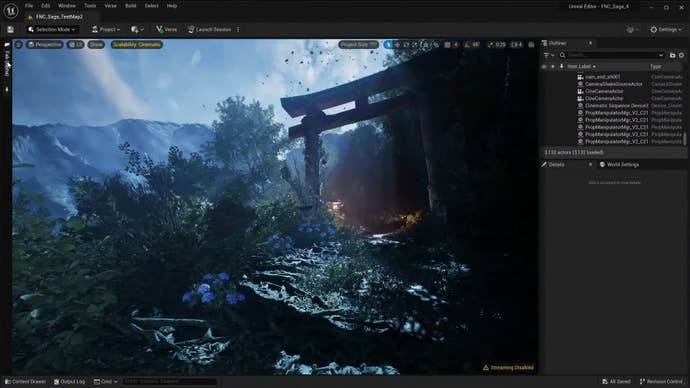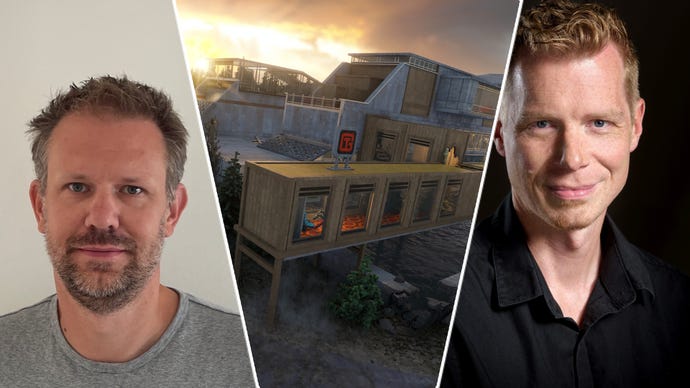Do voxels still have a place in the new age of modding and community creators?
While the duo were in San Fran for GDC, we sat down and talked to Dennis Dawson and Marcus Gustafsson about everyone's favourite voxels in Tuxedo Labs' Tearown.
It's a very interesting time for the tech that powers your favourite games. The industry is pushing forward on several fronts: AI, the metaverse, community content creation initiatives and, yes, even blockchain. It's easy to get the impression that we're on the precipice of a big new leap forward.
But where does that leave those who bet on the big cube roulette table that is voxel tech? We've seen some incredibly slick developments in that particularly geometric space over the past few generations; be it in gorgeous ray traced lighting, or jaw-dropping physics sandboxes. I spoke to Dennis Dawson and Marcus Gustafsson from Tuxedo Labs (best known for Teardown) about what place voxels have in an industry running forward at such a pace, and what we can expect from Tuxedo Labs in the future, too.
“We weren’t really ready to move on from Teardown. It’s still increasing in daily users - so we decided to hold off on a new game and keep working on Teardown," states Dawson, CEO at Tuxedo Labs. Teardown, a game that blew many away back when it released in 2020, continues to have a growing audience of casual players and creators alike even today. The pair say they considered moving onto a new game following the Art Vandal update in 2022, taking their adventures with voxel games "to the next step", but instead decided to stick with Teardown thanks to its active, and growing, player base.
“Technically, it will be more fun to start something new. It always is," Gustafsson reflects with a smile. "But I think it also makes more sense to stick to something that we already have an audience for. They love it, and there's a lot of content coming out.
“We're also very dependent on our modding community who create a lot of amazing stuff. If we have another Voxel game, we have the risk of splitting that community. Maybe they don’t both reach critical mass, and there’s a lot of risk with that. Also, we think the modding community will appreciate the features we have in mind in the future.”

This community of creators has grown to such a size and prestiget that AMD modding competitions for the game have sizable payouts for winning modders, who often put out some pretty stellar stuff. There's also dinosuars, which y'know, is kinda rad.
But more doors are being opened for this gaggle of voxel-smiths to leap to exciting new platforms. You need only look to the new Unreal Engine editor in Fortnite, or the creative sandbox of Everywhere, which was first announced during Gamescom Opening Night Live last year. Are voxels still as important as many speculated a decade ago?
"There’s been a discussion that voxels will eventually take over polygons and take over completely. I don’t think that’s true - not for a long time at least." Gustafsson pronounced. "Polygons are really good at certain things, and I think voxel is more like a complement that definitely opens up more dynamic environments."
Gustafsson continues: “Voxels are also a little bit more in the background. Maybe handing the lighting or AI or things that you don't fairly know about as a player. But they still played an important role from a technology perspective.”
There are benefits to sticking with voxels, even in this new age where publishers and developers are clearing their own path and pushing towards a bustling community creator environment. For one, voxels are easier for players to understand! Everyone gets LEGOs, but throw an Unreal Engine editor in front of someone starting out and would-be creators are liable to be intimidated. Being able to parse an in-engine pipeline from scratch is a daunting starting point.
And voxel titles now benefit from years of significant progress in lighting (with games like Minecraft being an obvious example of how nice you can make a once browser-based game look with the right treatment). Just look at some of the gorgeous ray tracing demos out there for an obvious point in voxels' favour.

As for the future of Voxels, Gustafsson believes it is "mostly going to be a complement to polygons going forward," pointing to how Teardown uses Voxels for physics and how future games could follow that example in addition to using polygons. The same goes for collision detection, ray tracing, audio acoustics, and so on. They're all tools that serve to make the final product greater than the sum of its parts.
As for what the pair is looking forward to when it comes to technical advances in the medium, the answer came to them quickly and without hesitation. AI. "I would say AI," states Gustafsson, eagerly. "It's really starting to take off. Yeah, at a pace I didn’t anticipate, and I think that's gonna have pretty drastic implications both for developers, but also for gameplay."
Dawson follows up by stating that AI has a lot of potential and pointed back to 2001 Lionhead title Black and White as a concept that could be interesting if done today. " That was too early. But doing something like that today would be amazing! Just playing with the AI, like having that fully incorporated into the gameplay. That would be amazing."
So rest assured that everyone's favourite video game cubes will retain some part of this grand future, whatever it is. It may not be as sexy right now as the metaverse or other big buzzwords, but voxels will likely be sticking around. After all, they're a great foundation to build from.

